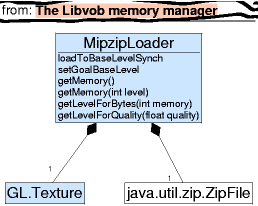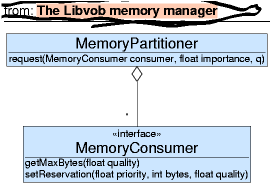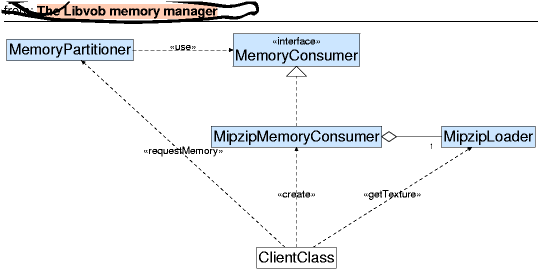The Libvob memory manager
This document explains the memory manager used in libvob to manage OpenGL texture memory. Other memory management is done using Java and C++ normally.
Mipzips - loading textures at reduced resolutions
The basic premises of texture memory are:
- Textures can be loaded at different resolutions, making a tradeoff between quality and space.
- Space is rather limited, as it's best to have the whole working set of textures on the video card.
When using Libvob in a system where there are several pictures, it is useful to be able to dynamically load and unload different levels of detail (this is a common term in Computer Graphics).
For performance and simplicity, Libvob currently uses mipmap level granularity for loading and unloading of textures: for being able to draw an image correctly at different scales, the graphics cards require a set of mipmaps to be stored in the graphics memory; the mipmaps start from the largest texture (both sides must be powers-of-two) and each successive mipmap level divides the size of the sides by two, requiring one fourth of the space of the preceding level.
We have chosen to store all mipmap levels of a texture in a .zip file and load on demand the requested levels.
The MipzipLoader class implements a basic interface to this functionality:

It is possible to use MipzipLoader synchronously, by calling loadToBaseLevelSynch, or asynchronously, by setting the goal mipmap level to load to, and loading will take place in the background. The class uses the Background and the OpenGL backgrounding functionality to load the textures, but the complications will not be described here.
The class also has methods to query the memory usage of the different levels &c, but these are best described in the Javadoc.
MemoryPartitioner - dividing memory between mipzips
The MipzipLoader class will not solve our texture memory problem by itself: it provides the mechanism to load textures at desired resolutions, removing and adding detail as necessary, but someone needs to make the decision which textures are important.
For some application architectures, this can be done by the application itself, centrally; however, e.g., in the Fenfire system, there may be different views and no single point that knows everything (due to polymorphism and encapsulation).
For this, we shall use an abstraction of a memory pool (MemoryPartitioner) and objects that want some memory but are able to degrade their quality gracefully when decreasing the amount of memory.

The way this is connected to mipzips is through MipzipLoader:

To do
To obtain better estimates of the relative importances of different textures, we should not only rely on calls when building the view but provide in, e.g., PaperQuad some feedback -generating routine which would allow us to read the number of pixels that were actually rendered (this is possible using some OpenGL extensions).